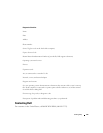
Glossary 149
resolutions up to 1280 x 1024.
SXGA+ — super-extended graphics array plus — A video
standard for video cards and controllers that supports
resolutions up to 1400 x 1050.
system board — The main circuit board in your computer.
Also known as the motherboard.
system setup — A utility that serves as an interface
between the computer hardware and the operating
system. System setup allows you to configure user-
selectable options in the BIOS, such as date and time or
system password. Unless you understand what effect the
settings have on the computer, do not change the settings
for this program.
T
TAPI — telephony application programming interface —
Enables Windows programs to operate with a wide variety
of telephony devices, including voice, data, fax, and video.
text editor — A program used to create and edit files that
contain only text; for example, Windows Notepad uses a
text editor. Text editors do not usually provide word wrap
or formatting functionality (the option to underline,
change fonts, and so on).
TPM — trusted platform module — A hardware-based
security feature that when combined with security
software enhances network and computer security by
enabling features such as file and e-mail protection.
travel module — A plastic device designed to fit inside
the module bay of a portable computer to reduce the
weight of the computer.
U
UAC — user account control— Microsoft Windows®
Vista™ security feature that, when enabled, provides an
added layer of security between user accounts and access
to operating system settings.
UMA — unified memory allocation — System memory
dynamically allocated to video.
UPS — uninterruptible power supply — A backup power
source used when the electrical power fails or drops to an
unacceptable voltage level. A UPS keeps a computer
running for a limited amount of time when there is no
electrical power. UPS systems typically provide surge
suppression and may also provide voltage regulation.
Small UPS systems provide battery power for a few
minutes to enable you to shut down your computer.
USB — universal serial bus — A hardware interface for a
low-speed device such as a USB-compatible keyboard,
mouse, joystick, scanner, set of speakers, printer,
broadband devices (DSL and cable modems), imaging
devices, or storage devices. Devices are plugged directly in
to a 4-pin socket on your computer or in to a multi-port
hub that plugs in to your computer. USB devices can be
connected and disconnected while the computer is turned
on, and they can also be daisy-chained together.
UTP — unshielded twisted pair — Describes a type of
cable used in most telephone networks and some
computer networks. Pairs of unshielded wires are twisted
to protect against electromagnetic interference, rather
than relying on a metal sheath around each pair of wires to
protect against interference.
UXGA — ultra extended graphics array — A video
standard for video cards and controllers that supports
resolutions up to 1600 x 1200.
V
video controller — The circuitry on a video card or on the
system board (in computers with an integrated video
controller) that provides the video capabilities—in
combination with the monitor—for your computer.
video memory — Memory that consists of memory chips
dedicated to video functions. Video memory is usually
faster than system memory. The amount of video memory
installed primarily influences the number of colors that a
program can display.
video mode — A mode that describes how text and
graphics are displayed on a monitor. Graphics-based
software, such as Windows operating systems, displays in
video modes that can be defined as x horizontal pixels by y
vertical pixels by z colors. Character-based software, such
as text editors, displays in video modes that can be
defined as x columns by y rows of characters.


















